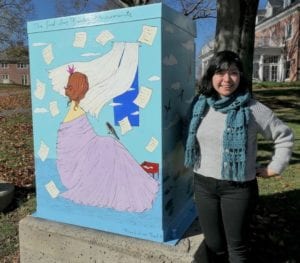Who is a member?
Our members are the local governments of Massachusetts and their elected and appointed leadership.

Pam Acosta, a participant in Electrify Amherst!, stands in front of the electrical box she painted in 2019. Her artwork is an example of the art that the Amherst Public Art Commission was encouraging before adoption of a new public art. (Photo courtesy Amherst Public Art Commission)
On Sept. 21, the Amherst Town Council unanimously approved a new “percent for art” bylaw that will require all municipal construction projects costing at least $1 million to put 0.5% of their budget toward the creation and installation of public art.
The bylaw, proposed by the Amherst Public Art Commission, is intended to increase the amount of visual art, including murals, sculptures, statues and mosaics, that is publicly accessible in municipal and government buildings. The bylaw will apply to four upcoming projects in Amherst: a library expansion, a new elementary school, a fire station renovation and a new public works building.
“It’s about creative placemaking,” said Amherst Public Art Commission Chair William Kaizen. “It makes places nicer spaces to live and work, and it can attract visitors and new residents.”
Public art is especially important to Amherst due to its unique history.
“Amherst is a town famous for the artists it has produced, from Emily Dickinson to Robert Frost,” said Kaizen.
But the town hadn’t taken steps to fund the arts since the turn of the century, he said, which made the bylaw even more important in the eyes of the commission.
“It’s a great thing for Amherst to do for its residents, visitors and people who work here,” Kaizen said. “This is just one way for towns to contribute to the liveliness of the community.”
First proposed in 2016, the original version of the “percent for art” bylaw included provision for performing arts as well as visual arts. Funding performers rather than installations proved to be too complex, however.
“Performers need a separate funding source than what is set aside for the process of building,” said Councillor Andrew Steinberg, who was a Selectboard member at the time of the original proposal. “The problem was that it was so unusual that it could not be done without special legislation.”
The Public Art Commission had to revisit the bylaw and then work to have it passed again, once Amherst changed its form of government to council-manager in 2018. The rewritten bylaw was about to go to a vote when the COVID-19 pandemic forced town hall to close to the public for several months.
“We got to a great place for this and then COVID-19 happened,” Kaizen said. “I was particularly worried about it passing council because of the financial impact of COVID. But once we brought it forward it passed unanimously.”
Kaizen and Steinberg both recommend that other towns look into similar bylaws.
“Where the funding is in a 20- or 30-year bond, the annual additional expense for paying back that debt is really only a few dollars a year,” Steinberg said. “The best place to start is to look at some of the art pieces that have been built across the country as part of ‘percent for art’ projects. I think that really makes the case for it.”
Written by Elisa Sturkie